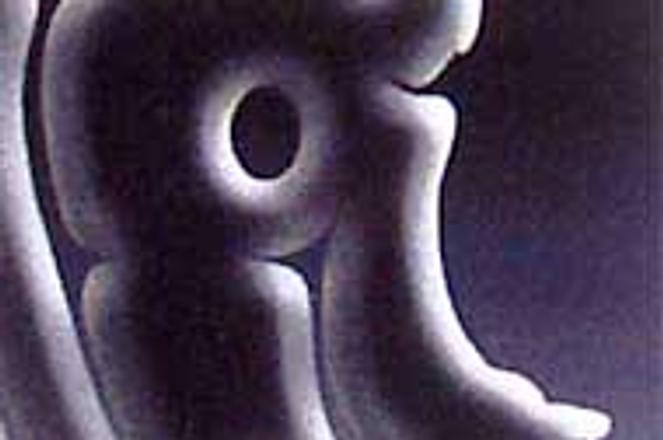JANKOVIČ'S computer graphic Jackanapeses . . .photo: Martin Marenčin
IN the years following 1968, when Warsaw Pact troops came to reinforce the fading communist regime in then Czechoslovakia, renowned sculptor Jozef Jankovič became excluded from public life for political reasons. Prohibited not only from exhibiting but also from creating his sculptures, he began to search for other means of self-expression.
He soon found himself experimenting with a rapidly developing technology - computer graphics.
On the one hand, Jankovič was limited by a lack of access to computers and by his reliance on a computer programmer. There were no more than two or three large computers in any of the state companies, and, because he was a layman, he needed a programmer to help him express his ideas through the complicated computer systems. On the other hand, he was exposed to the new possibilities that technology offered.
"I became fascinated by [the computer's] technical precision, how it could evenly capture a gradual movement - let's say a movement of a hand - which one couldn't achieve by drawing," says Jankovič, who, closely followed by artists Juraj Bartusz and Daniel Fischer, pioneered computer-graphic art in Slovakia in the early 1970s.
Before 1989, the regime was opposed to progressive art and pushed computer graphics to the background. However, the 1990s brought a revived interest in it.
When computers became part of everyday life, some people began to consider computer-graphic art to be the work of a computer rather than an artist. The artists, though, reject this idea.
AND his stone sculpture Room at the Top.photo: Martin Marenčin
"The computer is a great helper. It offers a wide range of opportunities for my work. However, if I didn't give the orders, the computer wouldn't create anything," says Viktor Hulík, one of a few computer-graphic artists in Slovakia who regularly use this technique in their work.
"It's artwork like any other type. It doesn't matter if the work comes out of a computer or an artist's hand; it always carries an artist's specific idea."
Perhaps the best way to address this issue is to compare artists' traditionally created works with their computer graphics, an idea that came out of the Slovak Virtual Gallery, an online portal of the Slovak art scene run by the Bratislava-based software firm ARS Nova.
The idea is part of a larger, long-term project, in which the virtual gallery plans to issue limited editions of original works by Slovak artists. The first edition, Album [ag] No 1, presents six computer graphics by six artists and was introduced at the project's accompanying exhibition 6G, which is currently running at Zichy's Palace in Bratislava.
While the 50 prints of the album enable art lovers to exhibit the six computer graphics at home, the accompanying exhibition - which displays a selection of the artists' paintings, drawings and graphic works in addition to their computer graphics - offers visitors a chance to compare the artists' hand-created works with their works created using computers.
"Computer art and its first experiments, which date back to 1950s, have been introduced gradually in Slovakia, with small and uncertain steps. There are only a few professional artists in Slovakia who regularly use computer graphics in their work. Some treat this media as a short-term experiment, coming back to it from time to time," says Andrea Kopernická from the virtual gallery.
The six artists who participated in the project represent three generations, and they all have different approaches to the computer technique. Jankovič, 65, who turned to computer graphics when it was in its infancy and discarded it as soon as the fall of communism enabled him to get back to his beloved sculptures, stands in contrast to young Svätopluk Mikyta, 29, who began to use this media when computers became an everyday necessity.
Viktor Hulík and Stanislav Stankoci represent the middle generation, which learned this technique because of their children. Also middle aged, Robert Jančovič and Vojtech Kolenčík have just become aware of the potential of computer graphics as an art form.
"Working with computers was an adventure back then," recalls Jankovič, referring to the beginnings of the technique, when mistakes in calculations created unique effects and the pictures from computers were reprinted using cameras. "A layman couldn't work with a computer, but now that is no problem. Art programmes are now part of every computer's menu, accessible to anyone.
"And what's the purpose of this art? Computer graphics are interesting only if you manage to create something different using the different technology."
What: 6G - Computer graphics of six artists.
Where: Galéria Z at Zichyho palác, Ventúrska 9, Bratislava.
When: Open Mon-Sat 12:00-18:00 until October 25.
Admission: free.
Tel: 02/5920-1611.
For more information on the exhibition as well as on obtaining the artists' works in Album No 1 visit www.artgallery.sk or contact ARS Nova at 02/6545-9102.


